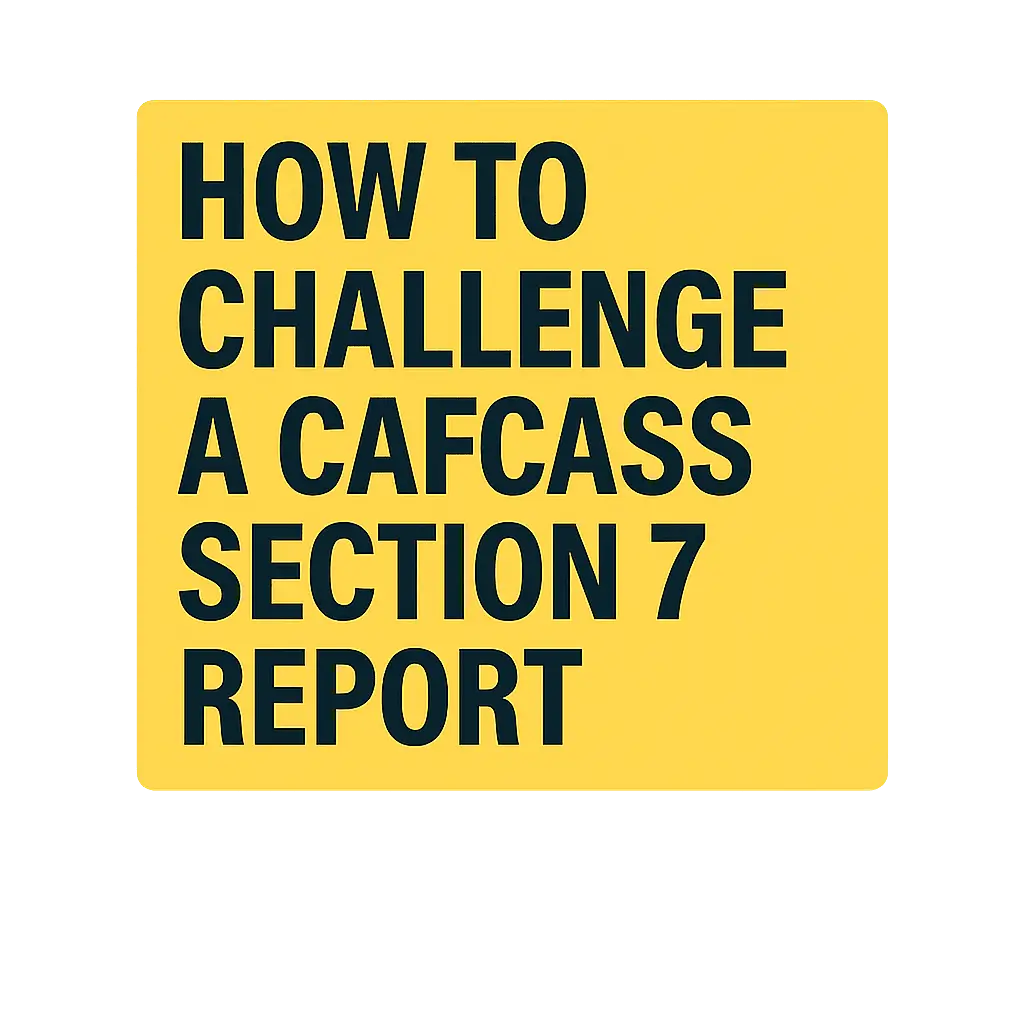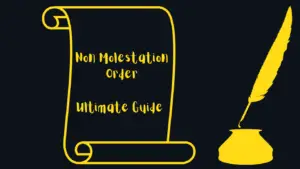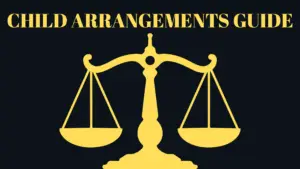Last Updated: 5 September 2025
You’ve just read the CAFCASS Section 7 report, and your heart sinks. The summary feels biased, the facts seem wrong, and the recommendations could be devastating for your relationship with your child. It’s a moment that can feel incredibly unjust and hopeless, leaving you angry and unsure of what to do next.
First, take a breath. Receiving an unfavorable report is not the end of the road. The family court process has built-in mechanisms for you to respond and challenge findings you believe are incorrect. Acting strategically, not emotionally, is now your most critical task. This guide will provide a clear, step-by-step plan for how to challenge a Section 7 report, correct the record, and ensure the judge hears your side of the story.
Key Takeaways
- A Report Can Be Challenged: Fathers often benefit from disagreeing with a Section 7 report when it’s inaccurate. The primary way to do this is by submitting a formal Position Statement or a new witness statement to the court.
- Focus on Facts and Evidence: The most effective challenges are based on factual inaccuracies and a failure by the officer to properly apply the Welfare Checklist. Simply stating “the officer was biased” is not enough.
- A Strategic Response is Crucial: Your written response should be respectful, acknowledge parts of the report you agree with, and then clearly and calmly outline the points of disagreement with supporting evidence.
- You Can Question the Officer in Court: At a final hearing, it is possible to request that the CAFCASS officer attends to be cross-examined on their report, allowing you to question their analysis and recommendations directly.
Just read a Section 7 report and feeling overwhelmed? Message us on WhatsApp — we’ll guide you through your next steps.
Jump To
- Understanding What You’re Challenging
- A Deep Dive: The Position Statement in Response
- A Real-World Scenario
- At a Glance: Effective vs. Ineffective Challenges
- A Real-World Example: Wording Your Response
- Common Mistakes That Will Weaken Your Challenge
- Frequently Asked Questions (FAQs)
- Challenge the Report with Clarity and Confidence
Understanding What You’re Challenging
Before you can challenge a Section 7 report, it’s vital to understand its purpose and structure. It is an investigation ordered by a judge under Section 7 of the Children Act 1989 to get more information about your child’s welfare. As a consultant who used to write these reports for CAFCASS, I know exactly what officers are looking for and where the weaknesses in a report can often be found.
A CAFCASS officer (a qualified social worker) is tasked with investigating your family’s circumstances by speaking with you, the mother, your child, and other professionals (like teachers). The entire investigation and the final recommendations must be based on the seven points of the Welfare Checklist. This legal framework is the benchmark against which the report’s quality and accuracy should be measured.
Unsure how to pick apart your report? WhatsApp us today for clear, line-by-line support.
A Deep Dive: The Position Statement in Response
Your primary tool for challenging a Section 7 report is your written response, usually in the form of a Position Statement or a supplemental witness statement.
Official Definition
A Position Statement is a short, concise document submitted to the court before a hearing. When responding to a Section 7 report, its purpose is to inform the judge of your view on the report’s contents. It allows you to highlight factual inaccuracies, challenge the officer’s analysis, and explain why you disagree with the recommendations, referencing the Welfare Checklist.
Acknowledge and Agree (Where Possible)
Start by respectfully acknowledging the report and agreeing with any parts that are accurate.
What This Means For You: Starting your response by saying, “I agree with the officer’s summary of my child’s educational needs in paragraph 12,” shows the court you are being reasonable and balanced, not just oppositional.
Identify and Correct Factual Inaccuracies
Create a clear, bullet-pointed list of any factual errors in the report (e.g., incorrect dates, names, or misquoted statements).
What This Means For You: This is your chance to correct the official record. Be specific: “At paragraph 15, the report states contact was missed on May 5th; the correct date, as shown in my evidence, was May 12th.”
Challenge the Analysis and Recommendations
This is the core of your challenge. A strategic approach is to explain why you believe the officer’s recommendations are wrong, linking your reasoning back to the child’s welfare.
What This Means For You: It’s important not to just state your disagreement. A constructive argument could be: “I disagree with the recommendation for supervised contact. The officer has based this on an unsubstantiated allegation and has not given sufficient weight to my child’s clearly expressed wish to resume unsupervised time, which is a key part of the Welfare Checklist.”
A Real-World Scenario
A father receives a report recommending less contact time because the officer felt he was not supportive of the child’s relationship with the mother. In his Position Statement, he respectfully disagrees. He points to paragraph 22 of the report, where the officer noted he helps his child buy birthday and Mother’s Day cards, and argues that this factual evidence was not given appropriate weight in the final analysis, demonstrating a flaw in the report’s logic.
Common Pitfalls
- Writing an angry, emotional response: A statement filled with rage or personal attacks on the officer will destroy your credibility.
- Only criticising the report: Failing to propose a positive alternative shows you are focused on the problem, not the solution.
- Submitting it late: The court sets a deadline for filing your response. Missing it may mean the judge doesn’t have time to read it.
At a Glance: Effective vs. Ineffective Challenges
| Feature | Effective Challenge ✅ | Ineffective Challenge ❌ |
|---|---|---|
| Tone | ✅ Calm, respectful, and professional. | ❌ Angry, emotional, and accusatory. |
| Focus | ✅ On factual inaccuracies and flaws in the report’s analysis. | ❌ On vague complaints of “bias” without specific evidence. |
| Evidence | ✅ References the Welfare Checklist and provides counter-evidence. | ❌ Makes unsubstantiated claims or personal attacks. |
| Format | ✅ A structured, concise Position Statement filed with the court. | ❌ An angry email sent to the CAFCASS officer’s personal inbox. |
| Goal | ✅ To persuade the judge that the recommendations are not in the child’s best interests. | ❌ To “punish” the CAFCASS officer for getting it wrong. |
Want your response to land like the “Effective” examples above? WhatsApp us for tailored drafting support.
A Real-World Example: Wording Your Response
Your written response is a formal court document. The language you use is critical.
Scenario: The report recommends you only have supervised contact, based on an allegation you believe is untrue.
Snippet from your response statement:
“Response to the Section 7 Report Recommendations
5. I have read the report of the CAFCASS officer, Ms. Smith, dated 5 September 2025. I agree with the officer’s summary of my child’s educational needs in paragraph 12.
6. However, I respectfully disagree with the recommendation for supervised contact at paragraph 34. This recommendation appears to be based solely on the mother’s allegation of verbal aggression, which is unsubstantiated and which I have always denied. The report does not include any corroborating evidence for this, nor does it reflect my child’s own expressed wish to resume unsupervised time with me, as noted in paragraph 21. I believe unsupervised contact, as was previously in place, is in my child’s best interests.”
🧠 Insider Insight from Lach:
“When a father gets a report he feels is unfair, the natural reaction is to fight. But you must fight smart. A judge is more likely to listen to a calm, logical argument that highlights flaws in the report’s reasoning than an emotional complaint about bias. Your job is to be the most reasonable person in the room. Take the report apart piece by piece, use its own words against it where possible, and always link your argument back to the Welfare Checklist. That is how you effectively challenge a recommendation.”
Common Mistakes That Will Weaken Your Challenge
- Making a personal attack on the CAFCASS officer: This is a cardinal sin in family court. Your challenge must be about the report’s content, not the officer’s character.
- Bombarding the court with irrelevant evidence: Your response should be focused and only include evidence that directly contradicts the report’s findings.
- Failing to offer an alternative: If you disagree with the recommendations, you must clearly state what Child Arrangements Order you believe is in your child’s best interests.
- Staying silent: If you do not formally challenge the report in writing, the court will assume you agree with its contents.
Frequently Asked Questions (FAQs)
Fathers often have the same urgent questions when they receive a Section 7 report they disagree with — here are the answers you need most.
How do you challenge a bad Section 7 report?
You challenge it formally through the court process. A strategic approach is to file a Position Statement or witness statement that clearly identifies factual errors, challenges the report’s analysis (linking it to the Welfare Checklist), and provides your own counter-proposals.
What if a CAFCASS report is inaccurate?
It’s important to list every factual inaccuracy in your written response to the court. For minor errors (like a misspelled name), you can also email the officer to ask for a correction. For significant errors that impact the recommendations, they must be formally challenged in your statement.
Do judges always follow CAFCASS recommendations?
Not always, but their recommendations carry significant weight. A judge must provide clear reasons if they decide to make an order that departs from the report’s recommendations. A strong, evidence-based challenge gives the judge the justification they need to do so.
Can I get a second CAFCASS report?
It is very rare to get a second Section 7 report from CAFCASS. It is more common to challenge the existing report. In exceptional circumstances, where a report is proven to be seriously flawed, a court might consider ordering a report from an Independent Social Worker (ISW), but this is costly and not guaranteed.
Can I complain to CAFCASS about a report?
Yes, you can complain to CAFCASS about the officer’s conduct, but their complaints procedure cannot be used to challenge the recommendations or professional judgment within the report. Disagreements with the report’s content must be addressed through the court process.
Can I question the CAFCASS officer in court?
Yes. The CAFCASS officer usually attends the next significant hearing after the report is filed. If you have formally challenged their report in your statement, the judge may allow you (or your representative) to cross-examine them on their findings.
How do you respond to false allegations in a Section 7 report?
A strategic approach is to deny them clearly and calmly in your written statement. You should provide any available counter-evidence that proves the allegation is false. Your case may be listed for a fact-finding hearing to determine the truth.
What happens if a judge disagrees with a Section 7 report?
The judge is the ultimate decision-maker. If they are persuaded by your evidence and arguments that the report’s recommendations are not in the child’s best interests, they can make a different order. They will provide a judgment explaining their reasons for departing from the report.
How much weight does a Section 7 report carry?
It carries a significant amount of weight. The CAFCASS officer is considered the court’s independent expert on child welfare. However, it is just one piece of evidence, and the judge will consider it alongside the statements and oral evidence from both parents.
Can a McKenzie Friend help me challenge a report?
Absolutely. An experienced McKenzie Friend is invaluable in helping you analyze the report, identify its weaknesses, draft a powerful response statement, and prepare for your court hearing.
Receiving a report that you feel is unjust can be a significant setback, but it’s important to know that you have a voice in this process. With our fixed-fee support, we can help you analyse the report and draft a response that gives you the best possible chance of being heard.
Challenge the Report with Clarity and Confidence
Don’t let a bad report define your case. The key is to act strategically and with the benefit of expert guidance.
At Dads Consultancy, we provide the specialised, expert support to help you navigate this process. Our founder is a former CAFCASS officer who has written these reports himself.
Don’t face a bad Section 7 report alone. Tap WhatsApp now and let’s prepare your strongest challenge together.
We know where the weaknesses lie and how to construct the most effective challenge. We can help you with:
- Navigating Section 7 Reports: intensive, line-by-line analysis of your report and expert guidance on how to respond.
- Drafting Powerful Position Statements: compelling responses that challenge inaccuracies.
- Handling the CAFCASS Call: preparation to set the right tone from the start.
- Making Your Application: ensuring your C100 form is completed flawlessly.
- Responding to Allegations: building factual, evidence-based responses.
An unfair report is not the final word. 👉 WhatsApp us today for a strategic consultation, and let’s build a clear plan to ensure your voice is heard.
🧠 Insider Insight: Lach, our founder, is a qualified social worker who used to write Section 7 reports for CAFCASS — the very reports that influence court outcomes. Now he helps dads respond to them. Learn more about Lach’s background.




